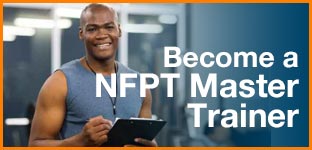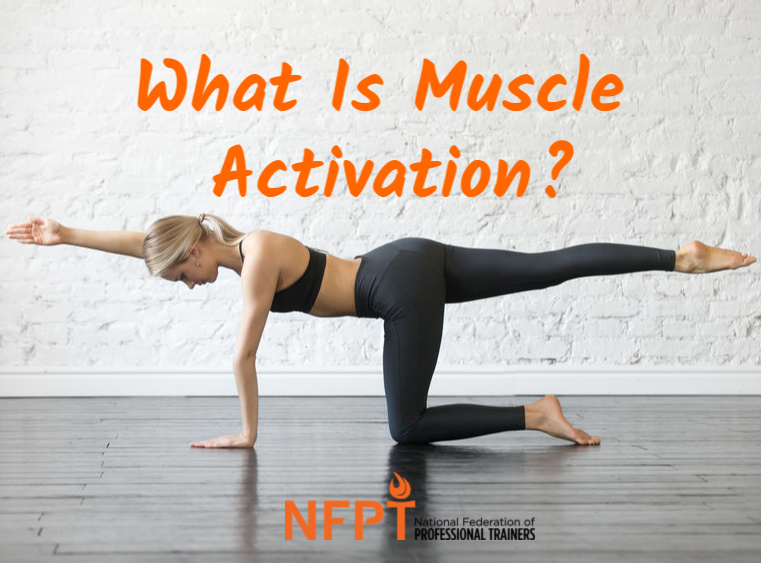If you’re a fitness professional you may have heard the term “muscle activation” or have even used it in your personal training practice as a means to help correct movement pattern dysfunctions. Defining exactly what this means and when it is appropriate to incorporate into an exercise program is an invaluable tool for anyone interested in the most efficient movement and integrated functioning possible.
 What is Muscle Activation?
What is Muscle Activation?
The Brookbush Institute (BI) defines muscle activation exercise as, “…an intervention developed with the intent of addressing a muscle exhibiting a reduction in activity (tone) as a result of, or contributing to, postural dysfunction.”
In other words, if your postural assessment using something like the Overhead Squat Assessment (OHSA) has pointed to particular muscle imbalances in which a muscle is probably underactive allowing synergistic dominance of other muscles, then a personal trainer could take the time to help the client reconnect with the underactive muscle.
“Activating” a muscle can be achieved by first isolating the underactive muscle as much as possible with a simple exercise to help establish a neural connection from brain to muscle. Oftentimes, this connection has become disruptive by chronic compensation and a faulty pattern has become hard-wired.
I’ll give you an obvious example: During an OHSA you see that the knees bow-in (knee valgus) indicating that the medial hip rotators and anterior adductors are overactive and the gluteus medius (and maximus, but we’ll just focus on one here) is underactive as a hip external rotator and abductor. Over time, the body will allow the synergistic dominance of the internal rotators like the TFL to control the squatting pattern, simply because it is now the path of least resistance; if the weakness of the glute medius is never corrected, the overactivity of the TFL will continue to be reinforced.
However, simple cueing in this case may not solve the problem, especially under loads. Telling your client to “push her knees apart” without first making sure that the glute medius is firing properly will probably result in continued knee valgus and frustration for both of you. (Been there? I know I have!)
Incorporating Muscle Activation Techniques
Muscle activation is only ever necessary for muscles that are deemed underactive following proper assessment. If you don’t feel qualified to conduct assessments that adequately define muscle imbalances but know something is “off” with your client, this might be a good time to refer out to another fitness professional who is, or even to a physical therapist.
A muscle when not at optimal functioning is either long/underactive (like the transverse abdominus, or TVA, post-pregnancy) or short/overactive (like the iliopsoas when an anterior pelvic tilt is present). But occasionally a muscle can also be long and overactive (the posterior deltoid is known for this—think rounded shoulders, but functionally dominant over shoulder external rotators), or even less likely, short and underactive (the psoas can fall under this too).
*It’s important to remember to release and stretch the overactive, synergistically dominant muscles before attempting muscle activation or you risk further reinforcement of the faulty movement pattern.
Muscles that require activation are always underactive.
Here is a list of muscles commonly underactive as described by the BI:
- Commonly Under-active (Phasic):
- Tibialis Posterior
- Tibialis Anterior
- Tibial Internal Rotators
- Vastus Medialis
- Gracilis
- Semitendinosus/Semimembranosus
- Popliteus
- Gluteus Maximus
- Gluteus Medius
- Transverse Abdominis
- Serratus Anterior
- Lower Trapezius
- Shoulder External Rotators (Infraspinatus and Teres Minor)
- Deep Cervical Flexors (Longus Colli, Longus Capitis and Rectus Capitis Anterior)
(The above hyperlinks include activation exercises for those muscle groups.)
Performing the proper isolation activity is not always as obvious as you might think. You will have to thoughtfully position the body so as to minimize contribution from overactive synergists. For instance, in the case of the gluteus maximus–the biceps femoris, lumbar extensors, and even adductor magnus like to take over.
So how to recruit and activate glute max only?
Place the lumbar spine in slight flexion (reduce lumbar flexion), abduct the leg (reduce adduction). and extend the knee (reduce hamstring knee flexion). So imagine your client lying prone on the floor (lying prone or supine is always the best place to start so as to relax all other areas of the body so the client can focus on the muscle contraction and activation), you would cue him or her to pull the naval away from the floor, place knee in extension, and slightly abduct the leg while slow extending the hip to connect with the glute max.
Glute medius responds to activation in the clamshell position, which can be progressed to band resistance and then straight leg abductions.
Something like the TVA can be even trickier. It’s already a unique and deep muscle, so if global core muscles are dominant in attempting to stabilize the trunk, trying to separate them out can be difficult to cue. The best way to do this is to instruct your client to lie supine with knees bent and spine neutral. If she places her fingers just below and medial to the ASIS bones of the pelvis and relaxes, the tissue beneath should be soft in absence of a contraction.
Cueing the client to “pull up” the pelvic floor muscles might be the most difficult one to relay since you can’t see it happen and the client might be experiencing something somewhat different than what you’re trying to explain. But the best way to ensure your cue is being properly conveyed is by watching your client’s fingers palpating their own abdomen. Have them associate pelvic floor engagement with stopping the flow of urine and visualizing pulling the organs up towards the ribcage. Then cue them to pull the lower abdomen away from their waistband, but only a bit.
When done properly, the muscles beneath the fingers should firm up but not bulge. If the internal obliques become involved (a common compensation) the abdominal muscles will all tense up and push out, moving the fingers pretty noticeably. If you see this happen, you can help guide your client into calming down that compensation and gently work on gentle contractions while breathing out, and relaxing completely while breathing in. Once this happens successfully with the proper TVA contraction, your client can focus on maintaining the contraction while breath flows in and out.
Mastering this TVA activation is truly the foundation of ALL core work and without it, compensatory patterns will certainly become prominent. This can be progressed with quadruped stability exercises like bird-dog.
Timing and Patterning
Providing manual assistance may be necessary at first. This means, placing your client in the correct position to activate the target muscle and helping them perform the movement until their body can replicate the motion without your assistance. Up to five reps may be all that is necessary here.
After that is mastered, you may even apply external resistance with your hand (push down slightly on the lower leg while performing hip extension during glute max activation for an additional 5 to 10 reps of increasing difficulty.
Once it is clear the mind-muscle connection has been established they should perform the activation on their own, adding resistance necessary to work in the 12-20 rep range.
One to two sets is all that is necessary per session.
A 4-second eccentric, 2-second isometric, and 2-second (4:2:2) concentric tempo will help to promote eccentric control. This is most appropriate for most scenarios when a muscle is barely participating in kinesthetic motion. Perhaps this is the best choice for underactive or inhibited TVA or even external shoulder rotaters (since the overactive synergists can pretty much take over their function).
A tempo 2:4:2 will promote strength at the muscle’s end range. This might be an ideal approach for gluteus maximus when an anterior pelvic tilt is present and the muscle is more inhibited at full hip extension. (We know as the primary hip driving force the gluteus maximus will always exhibit some activity or else hip extension —standing up from a seated position— would never occur).
Rather than getting too hung up on the tempos, help your client focus on making these important neural connections which are really the foundation with efficient movement and muscle performance, and visually assess the muscle performance and probably synergist activity. Reassessment after activation training is not only recommended but is the only way to determine if your efforts have been fruitful.

References
https://brookbushinstitute.com/article/introduction-to-activation-exercise

 What is Muscle Activation?
What is Muscle Activation?

